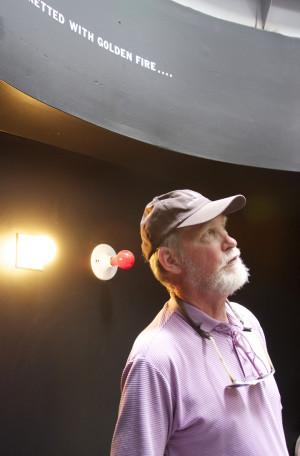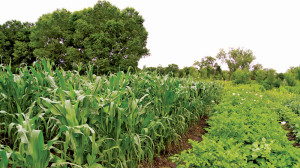by Tina Mitchell
Just after June’s summer solstice, my husband and I were enjoying a lazy morning, drinking coffee and watching television, when movement outside the windows caught my eye. Probably a mule deer heading for a drink from the birdbath, I thought as I stood up to look. Whoa – definitely not a deer. A slender, light brown bear ambled across the patio.
What was wrong with this picture?
First, this bear was at least the third ursine appearance here since Memorial Day. Our arid, scrubby, piñon/juniper habitat offers very little food for a bear, especially in early summer. An omnivore, a bear’s diet includes grasses, nuts and acorns, berries and fruits, insects, eggs, carrion, tubers, small mammals, garbage, bird seed – and of course, Winnie-the-Pooh’s favorite, honey. Our property offers very few of these options, especially since we had taken down our bird feeders around Memorial Day after a much larger bear paid us a visit and trashed the feeders. In past years, we would see signs of bears – huge piles of scat, destroyed bird feeders – starting around mid-August as bears begin to prepare for hibernation. During our smart years, we took down our bird feeders before then; during our dumb or forgetful years, we took them down immediately after that. But this early? The thought hadn’t even entered our minds before that Memorial Day bear.
Second, this bear was out in broad daylight. Most of the time, bears are nocturnal or at least crepuscular (active at twilight). The primary exception occurs just about this time of year – late summer and fall – as bears prepare for five months or more of hibernation. During this period, they range far and wide in a pre-hibernation “bulk up” – by some reports, feeding up to 20 hours a day, ingesting 10,000–15,000 calories daily, and packing on 20–30 pounds a week. This process is known as hyperphagia, literally meaning “overeating.” But this bear appeared in June, several months before hyperphagia should have started.
Third, this bear seemed noticeably slight, especially compared to a third bear we had watched one late evening from our second-floor porch earlier in June. Black bears, along with the other eight species of bear throughout the world, are the planet’s largest living carnivores. Adult males can weigh more than 400 pounds; adult females, up to 180 pounds. Although this bear seemed smaller than other adult bears we’ve seen, it looked healthy. The time of year offered a possible clue about its daytime presence in our bear-unfriendly area. Black bears breed in June and July. Typically, a female gives birth to two cubs in her winter den; she then doesn’t breed the summer following those births. As a result, young bears often stay with their mothers into their second year. But during that second year, the mother is ready to breed again and chases these young off to find their own way in the world. Given the timing of this visit – and our inhospitable habitat for any self-respecting adult bear – perhaps this bear had just been evicted by Mom and was seeking a new territory.
One aspect of this solstice bear that was not unusual was its light brown color. The name “black bear” denotes a species rather than a specific hue. Black bears in Colorado exhibit a wide variety of fur colors, including blond, cinnamon and brown. In fact, Colorado Parks and Wildlife estimates that 83 percent of Colorado black bears are actually brown.
So for the next few months, be “bear aware” as Colorado’s bears enter hyperphagia, sometimes traveling scores of miles in search of food. Bears are smart, curious and quick learners, with lousy eyesight, moderately acute hearing, and extraordinary senses of smell. So be extra careful with any smells suggestive of food – greasy grills, baked goods cooling near an open window, bird feeders of any kind, pet food left outside … Try to keep your property boring and uninteresting, so a bear doesn’t make a potentially deadly mistake. Colorado Parks and Wildlife has a “two strikes and you’re out” policy for bears. The first time one causes trouble for humans, it is tranquilized, ear-tagged and transported to a better habitat; the second time, it’s euthanized. The bottom line is that people create problem bears. Let’s all do what we can to coexist peacefully with these magnificent omnivores for the next few months, until they head off for hibernation and we can all breathe a bit easier.
Tina Mitchell watches nature with her human and canine family from their perch in the piñon/juniper habitat of western Fremont County. When she needs to pay the bills, she shows up as a research psychologist on the University of Colorado Anschutz Medical Campus in Aurora.


